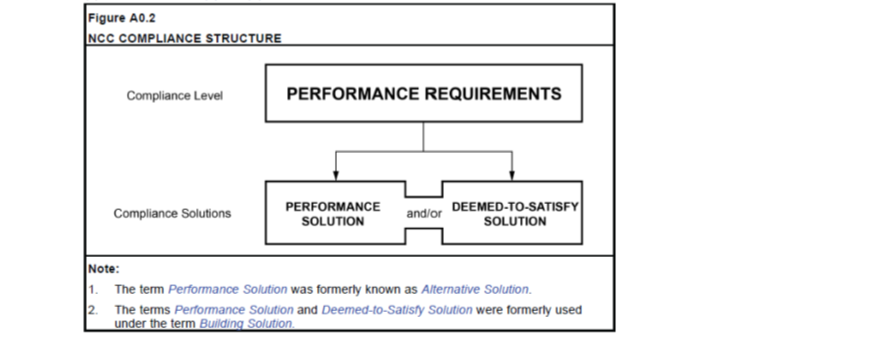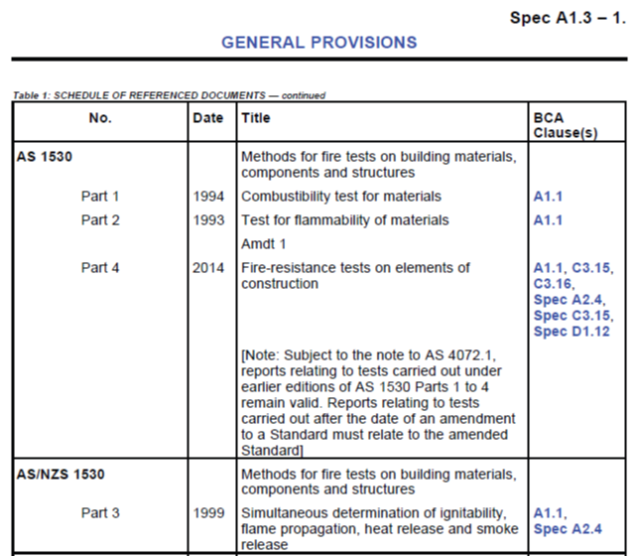- 2 Minutes to read
- Print
- PDF
Compliance
- 2 Minutes to read
- Print
- PDF
With so many possible combinations of scenarios and solutions for external walls – it’s important to understand the selection process for a compliant system.
This section will only deal with the panel selection based on combustibility criteria – part J insulation, speed of construction, wind load resistance or any other factors other than combustibility are not considered in this document.
1. The NCC sets out the minimum requirements for a building and provides for DTS and/or performance solutions (Section A0.2/A0.3).
A0.2 Meeting the Performance Requirements
The Performance Requirements can only be satisfied by a -
a) Performance Solution; or
b) *Deemed-to-Satisfy Solution;*or
c) combination of (a) and (b)

A0.3 Performance Solutions
a) A Performance solution must -
i) comply with the Performance Requirements; or
ii) be at least equivalent to the Deemed-to-Satisfy Provisions, and be assessed according to one or more of the Assessment Methods.
b) A Performance Solution will only comply with the NCC when the Assessment Methods used satisfactorily demonstrate compliance with the Performance Requirements.
2. A performance solution must be documented as per Clause A2.2 of the NCC
A2.2 Evidence of suitability
a) Subject to A2.3 and A2.4, evidence to support that the use of a material, form of construction or design meets a Performance Requirement or a Deemed-to-Satisfy Provision may be in the form of one or a combination of the following:
i) A report issued by a Registered Testing Authority, showing that the material or form of construction has been submitted to the tests listed in the report, and setting out the results of those tests and any other relevant information that demonstrates its suitability for use in te building.
ii) A current Certificate of Conformity or a current Certificate of Accreditation.
iii) A certificate from a professional engineer or other appropriately qualified person which -
A) certifies that a material, design, or form of constructio complies with the requirements of the BCA; and
B) sets out the basis on which it is given and the extent to which relevant specifications, rules, codes of practice or other publications have been relied upon.
iv) A current certificate issued by a product certification body that has been accredited by the Joint Accreditation System of Australia and New Zealand (JAS-ANZ)
v) * * *
vi) any other form of documentary evidence that correctly describes the properties and performance of the material or form of construction and adequately demonstrates its suitability for use in the building.
b) Evidence to support that a calculation method complies with an ABCB protocol may be in the form of one or a combination of the following:
i) A certiciate from a professional engineer or other appropirately qualified person which -
A) certifies that the calculation method complies with a relevant ABCB protocol;
B) Sets out the basis on which it is given and the extent to which relevant specifications, rules, codes of practice and other publications have been relied upon.
ii) Any other form of documentary evidence that correctly describes how the calculation method complies with a relevant ABCB protocol.
3. The NCC references certain Australian Standards which are mandatory as a part of the DTS solution and are also considered by a Performance solution (per NCC A0.5) to ensure its providing comparable performance.

For example – non-combustible (a DTS requirement using AS 1530.1) may be considered equal to very limited combustible (eg AS 1530.3 tested) + sprinklers by a fire engineer and the certifier/building surveyor – meaning either can be used – this directly affects what products that can be used.

